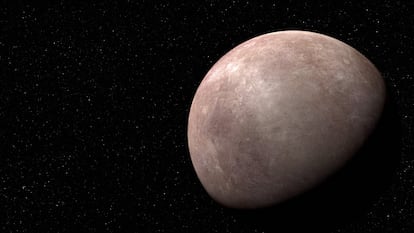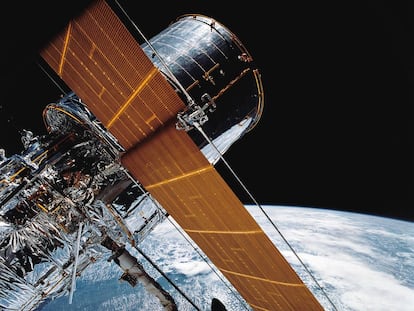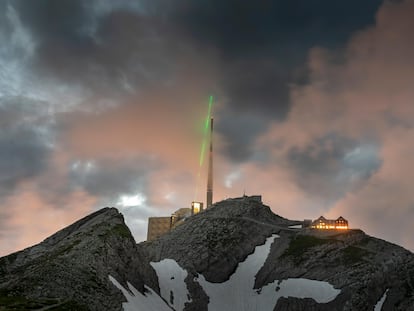The telescope with which NASA intends to search for new worlds
A new project known as the Habitable World Observatory aims to better understand near-Earth exoplanets and study those that could support life

More than 5,000 exoplanets are known. Among them, almost three hundred meet the conditions to support some form of life: being rocky bodies (not gaseous) that orbit a star that is not wildly active at a distance suitable for its temperature to allow for the existence of liquid water.
Until now, all these planets have been detected by analyzing small variations in the brightness of their star. Some have been photographed as simple bright dots in images captured from ground observatories. We do not know any characteristics of their surface; they could be desert planets or oceanic worlds. Chemical compounds (methane, carbon dioxide and even oxygen) have been detected in some, but in general they are giant planets, hardly suitable for life.
Now, with the Hubble telescope still active and the James Webb Telescope sending extraordinary stellar views to Earth, NASA is contemplating an even more ambitious project: the Habitable World Observatory (HWO), whose mission is divided between advanced astrophysical research and photographing the surfaces of extrasolar planets.
Although the HWO is still in its preliminary design phase, researchers have been testing the components that will someday go into space for more than two years. For now it is conceived as a telescope with a four-meter diameter (almost twice as much as the Hubble, but less than the Webb) created to study bands of ultraviolet, visible and near-infrared light.
Its size will allow it to be set in the nose cone of a conventional rocket without folding it, as was the case with the Webb. The one-piece mirror will have to be manufactured to tolerances a thousand times tighter, as it will detect visible and ultraviolet radiation, with wavelengths shorter than infrared. Preliminary studies suggest that polishing should remove any irregularities greater than a billionth of a millimeter, less than the diameter of an atom.
Such a mirror is very fragile. The impact of a single speck of dust would cause an irregularity that would provoke an unwanted scattering of light, which would in turn degrade the observations. For this reason, the new telescope will look more like a Hubble than a Webb: a metal tube that protects the optical system and prevents the entry of stray light.
However, even with the best mirror, detecting and photographing such remote planets is very difficult, as they move within the brightness of their star. This is why all the satellites employed for this task use a small opaque disk known as a coronagraph that hides the star, preventing glare and showing only the tiny dots of light that revolve around it.
It is a process that requires immense precision. The telescope must be pointed exactly at the center of the star. Under these conditions, the light from a possible planet will reach it at an angle of almost zero degrees, but not quite zero. Detecting that tiny difference requires complicated, optical systems and – of course – a very stable telescope.
One of the discarded projects used a gigantic glare blocker: a 50-meter wide starshade designed to fly in formation with the telescope – almost 100,000 kilometers away. Although tests had been carried out on a reduced scale, it was considered too risky and NASA went with the alternative option: a more conventional coronagraph that is housed inside the telescope’s optical system.
The telescope will be placed in an orbit around the L1 Lagrange point, 1.5 million kilometers from Earth. That is the same area that the Webb and other satellites orbit, but there is no danger of collision; space is too big for that. At that distance, any repair is impossible, at least today, but the design of the HWO takes into account the possibility of being visited by maintenance and refueling robots, which would extend its useful life.
What results can be expected? The answer can only be based on statistics, reliant on the number and nature of the exoplanets that have been detected so far. Some estimates suggest that signs compatible with life may be detected in approximately 25 near-Earth bodies (“near” meaning tens of light-years away). Other less optimistic forecasts expect to study the surface of two or three planets similar to ours.
The viability of this monumental project depends on financing. So far, NASA only has $1.5 billion approved for all its astrophysics projects for the fiscal year – almost 5% less than last year. A very conservative estimate of the cost of the HWO telescope is around $10 billion. However, if the Webb experience can be taken as an example, that figure could double over the nearly twenty years the project will last. At best, the first photographs of the surface of other worlds will not arrive until well into the next decade.
Sign up for our weekly newsletter to get more English-language news coverage from EL PAÍS USA Edition
Tu suscripción se está usando en otro dispositivo
¿Quieres añadir otro usuario a tu suscripción?
Si continúas leyendo en este dispositivo, no se podrá leer en el otro.
FlechaTu suscripción se está usando en otro dispositivo y solo puedes acceder a EL PAÍS desde un dispositivo a la vez.
Si quieres compartir tu cuenta, cambia tu suscripción a la modalidad Premium, así podrás añadir otro usuario. Cada uno accederá con su propia cuenta de email, lo que os permitirá personalizar vuestra experiencia en EL PAÍS.
¿Tienes una suscripción de empresa? Accede aquí para contratar más cuentas.
En el caso de no saber quién está usando tu cuenta, te recomendamos cambiar tu contraseña aquí.
Si decides continuar compartiendo tu cuenta, este mensaje se mostrará en tu dispositivo y en el de la otra persona que está usando tu cuenta de forma indefinida, afectando a tu experiencia de lectura. Puedes consultar aquí los términos y condiciones de la suscripción digital.
More information
Archived In
Últimas noticias
All the effects of gentrification in one corner of Mexico’s Colonia Roma
Palestinian reporter Youmna El Sayed: ‘My family told me I had to choose between being a journalist or a mother’
Russell Tovey: ‘I was advised many times not to come out, I don’t think there was many people who’d done that — and I feel really proud that I’m one of those that did’
Merz tries to replace Macron at the helm of Europe
Most viewed
- The low-cost creative revolution: How technology is making art accessible to everyone
- Families demand repatriation of bodies of Colombians who died in Ukraine: ‘This war is a slaughterhouse for foreigners’
- Christian Louboutin: ‘Young people don’t want to be like their parents. And if their parents wear sneakers, they’re going to look for something else’
- US sanctions against jailed cartel leader ‘El Marro’ highlight Mexico’s lack of control over its prisons
- Liset Menéndez de la Prida, neuroscientist: ‘It’s not normal to constantly seek pleasure; it’s important to be bored, to be calm’











































